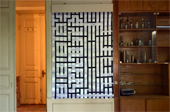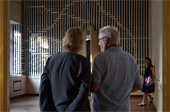
Woven Architecture at State Silk Museum
By Mariam Chanishvili
Tuesday, July 23
Woven Architecture - Australian visual artist Fiona Davies exhibition opening took place on 18th July at the State Silk Museum.
“Woven Architecture” is a site-specific weaving in three sites within the State Silk Museum. The weaving is made of ribbon and is made of and on the architecture of the site. The exhibits include the satin ribbon colored black, white and off white are woven into variations of the sateen weave.
“By using ribbon, the weaving process can be off-loom. The architecture is the structure holding the fabric. Both the satin weave as ribbon and the sateen weave as architecture have long floating lengths which are highly reflective, shiny, or luxurious. The woven surface performs as a photonic device embedded in the architecture of the State Silk Museum,” reads the description of the exhibition.
While changing the angles and daytime, the visitors can notice that the work changes color and tone.
Fiona Davies is an Australian transdisciplinary visual artist working with the medical, emotional, physical, technical and economic landscapes of medicalized death in ICU. The technology of silk biomedical devices informs her work, where data visualization of the performance of specific parameters of the body is represented in unexpected ways.
The artist noted that this is her second exhibition organized at the State Silk Museum of Georgia.
“It is very important to be working here, in this space, because this is one of the oldest museums in the world. My work expresses the biomedical aspects of life. At a glance, these are just shiny ribbons, but in reality, it represents the lines of medical diagram,” said Fiona Davies.
The State Silk Museum is one of the oldest museums in Georgia. Established in 1887, it was a part of the Caucasian Sericulture Station. The complex of the station is located near Mushtaidi Park, and it worked on the basis of the European model – including practical and educational activities. The museum has its library, which keeps various literature about natural sciences in several languages and works of station staff members in the 19th century.
The building was constructed in 1892 by the architect Alexander Szymkiewicz.



